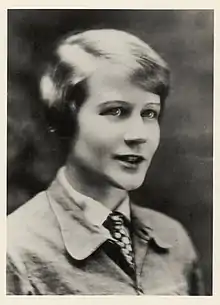Ilse Fehling
Ilse Fehling was a German costume designer and sculptor associated with the Bauhaus and Nazi propaganda films.
Ilse Fehling | |
|---|---|
 Ilse Fehling in 1928 | |
| Born | April 25, 1896 Danzig-Langfuhr, Germany |
| Died | February 25, 1982 Munich, Germany |
Education
Ilse Fehling was born on April 25, 1896 in Danzig-Langfuhr, Germany. In 1919, Fehling enrolled at the Reimann School in Berlin, where she studied art and fashion design. While in Berlin, she additionally studied at the city's Kunstgewerbeschule.[1] It was there that Fehling studied sculpture.[2]
In 1920, Fehling matriculated at the Bauhaus Weimar, where her work involved theatre. At the school she studied sculpture, theater, painting, and theory of harmonization[3] under a number of prominent artists including Oskar Schlemmer, Paul Klee, and Gertrud Grunow.[4] Out of her work at the school, Fehling's best known is the rotating round puppet stage she designed and later patented[5] in her theater class with Lothal Schreyer[6].
Career
In 1923, she left the Bauhaus for Berlin to work as a freelance sculptor and stage and costume designer.[4] Fehling married Henry S. Witting the same year. In 1928, Fehling gave birth to a daughter, Gaby; she divorced Witting a year later.[1]
Fehling received the Rome Prize from the Prussian Academy of Arts in 1932; she later studied in Rome using a grant associated with the award.[1] In the following years, her work took influences from Cubism.[4]
Following the Nazi rise to power, Fehling's work was deemed degenerate and its exhibition was banned.[4] Much of her work was lost due to bombing and confiscation during World War II.[1]
Ilse Fehling worked as a costume designer for a number of Nazi propaganda films, including Der Herrscher.[7]
In 1940, Ilse Fehling began work at Tobis-Europa as the chief outfitter.[8] Here she optimized the costume department by expanding and continuing to develop it.[9] While working there, Fehling implemented reprocessing costumes for "artistic costume utilization".[10]
By 1946, Fehling lived in Rottack before returning to Munich in 1952 where she would live the rest of her life.[11] Fehling opened her own studio after settling in Munich, where she worked on sculptures, stage sets, and press drawings.[12] Ilse did some additional work in Geneva, where her daughter was an international student.[13] Her final design project was for the Cologne cinema Die Lupe in 1965, where she conceptualized the interior design.[14]
Fehling died on February 25, 1982.
References
- "Ilse Fehling". www.bauhaus100.com. Retrieved 2019-04-06.
- "Biografie". www.bauhauskooperation.de (in German). Retrieved 2022-05-03.
- "Biografie". www.bauhauskooperation.de (in German). Retrieved 2022-05-03.
- Gotthardt, Alexxa (2017-04-03). "10 Forgotten Female Pioneers of the Bauhaus". Artsy. Retrieved 2019-04-06.
- "Mujeres en la Bauhaus". La Vanguardia. 2019-03-12. Retrieved 2019-04-06.
- "Biografie". www.bauhauskooperation.de (in German). Retrieved 2022-05-03.
- Jung, Gerrit (2014-04-11). Veit Harlan – Ein Filmemacher im Faschismus (in German). diplom.de. ISBN 9783836631051.
- "Biografie". www.bauhauskooperation.de (in German). Retrieved 2022-05-03.
- "Biografie". www.bauhauskooperation.de (in German). Retrieved 2022-05-03.
- "Biografie". www.bauhauskooperation.de (in German). Retrieved 2022-05-03.
- "Biografie". www.bauhauskooperation.de (in German). Retrieved 2022-05-03.
- "Biografie". www.bauhauskooperation.de (in German). Retrieved 2022-05-03.
- "Biografie". www.bauhauskooperation.de (in German). Retrieved 2022-05-03.
- "Biografie". www.bauhauskooperation.de (in German). Retrieved 2022-05-03.